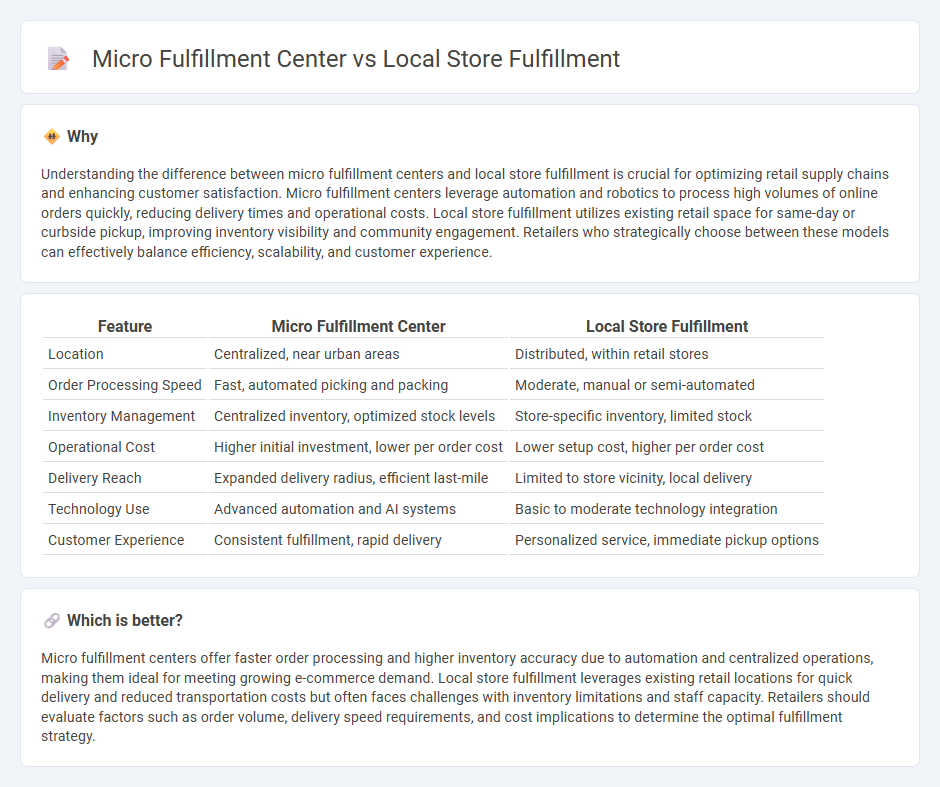
Micro fulfillment centers enhance retail efficiency by using automated systems to process online orders quickly within urban areas. Local store fulfillment leverages existing brick-and-mortar inventory, offering faster delivery but limited by store capacity and layout. Discover how integrating these models can optimize your retail strategy today.
Why it is important
Understanding the difference between micro fulfillment centers and local store fulfillment is crucial for optimizing retail supply chains and enhancing customer satisfaction. Micro fulfillment centers leverage automation and robotics to process high volumes of online orders quickly, reducing delivery times and operational costs. Local store fulfillment utilizes existing retail space for same-day or curbside pickup, improving inventory visibility and community engagement. Retailers who strategically choose between these models can effectively balance efficiency, scalability, and customer experience.
Comparison Table
| Feature | Micro Fulfillment Center | Local Store Fulfillment |
|---|---|---|
| Location | Centralized, near urban areas | Distributed, within retail stores |
| Order Processing Speed | Fast, automated picking and packing | Moderate, manual or semi-automated |
| Inventory Management | Centralized inventory, optimized stock levels | Store-specific inventory, limited stock |
| Operational Cost | Higher initial investment, lower per order cost | Lower setup cost, higher per order cost |
| Delivery Reach | Expanded delivery radius, efficient last-mile | Limited to store vicinity, local delivery |
| Technology Use | Advanced automation and AI systems | Basic to moderate technology integration |
| Customer Experience | Consistent fulfillment, rapid delivery | Personalized service, immediate pickup options |
Which is better?
Micro fulfillment centers offer faster order processing and higher inventory accuracy due to automation and centralized operations, making them ideal for meeting growing e-commerce demand. Local store fulfillment leverages existing retail locations for quick delivery and reduced transportation costs but often faces challenges with inventory limitations and staff capacity. Retailers should evaluate factors such as order volume, delivery speed requirements, and cost implications to determine the optimal fulfillment strategy.
Connection
Micro fulfillment centers (MFCs) and local store fulfillment work together to enhance retail supply chains by enabling faster order processing and delivery. MFCs use automation and compact storage near urban areas to quickly prepare orders, which local stores then complete through last-mile delivery or curbside pickup. This integration reduces delivery times, lowers transportation costs, and improves inventory accuracy, driving higher customer satisfaction in omnichannel retail environments.
Key Terms
Inventory Management
Local store fulfillment leverages existing retail inventory to expedite order processing and reduce last-mile delivery costs, whereas micro fulfillment centers (MFCs) utilize automated systems within compact urban warehouses to optimize stock levels and increase picking efficiency. Inventory management in local store fulfillment requires real-time synchronization across multiple locations to prevent stockouts and overstocks, while MFCs benefit from centralized, data-driven inventory control that enhances accuracy and turnover rates. Explore the advantages of each model to optimize your supply chain and inventory strategy effectively.
Order Processing Speed
Local store fulfillment accelerates order processing by leveraging inventory already available on-site, enabling rapid picking and packing for same-day delivery. Micro fulfillment centers use automated systems and compact warehouses situated near urban areas to optimize order accuracy and speed with high throughput capacity. Explore further to understand which solution best enhances your supply chain efficiency.
Last-Mile Delivery
Local store fulfillment leverages existing retail locations to quickly process and deliver online orders, reducing delivery times and enhancing customer satisfaction through proximity. Micro fulfillment centers utilize automated, compact facilities situated close to urban areas, optimizing inventory management and accelerating last-mile delivery efficiency. Explore further to understand how these strategies transform the future of last-mile delivery logistics.
Source and External Links
Boost Your E-Commerce Business with Local Fulfillment Services - Local store fulfillment involves storing products in multiple small warehouses or distribution centers close to customers, enabling faster shipping, cost efficiency, and improved customer experience by reducing delivery times and handling returns more quickly.
In-Store Fulfillment - Deck Commerce - Local store fulfillment can turn physical stores into mini fulfillment centers where orders are picked, packed, and shipped directly from stores or prepared for in-store or curbside pickup, using smart order routing based on inventory, proximity, and store capacity.
Understanding Store Fulfillment: What Retailers Need to Know - Store fulfillment is a logistics strategy that leverages retail stores' inventory and infrastructure to fulfill online orders quickly through shipping or in-store pickup, reducing costs and delivery times while improving inventory turnover and customer satisfaction.
 dowidth.com
dowidth.com